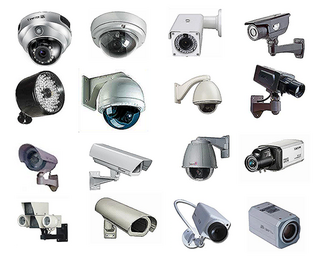Dynamic range is the ratio between the largest and smallest values that a certain quantity can assume. It is often used in the context of signals, like sound and light. It is measured either as a ratio or as a base-10 (decibel) or base-2 logarithmic value of the difference between the smallest and largest signal values.

A traffic enforcement camera is a camera which may be mounted beside or over a road or installed in an enforcement vehicle to detect motoring offenses, including speeding, vehicles going through a red traffic light, vehicles going through a toll booth without paying, unauthorized use of a bus lane, or for recording vehicles inside a congestion charge area. It may be linked to an automated ticketing system.

In photography and videography, HDR or high-dynamic-range imaging is the set of techniques used to reproduce a greater range of luminosity than that which is possible with standard photographic techniques. Standard techniques allow differentiation only within a certain range of brightness. Outside this range, no features are visible because in the brighter areas everything appears pure white, and pure black in the darker areas. The ratio between the maximum and the minimum of the tonal value in an image is known as the dynamic range. HDR is useful for recording many real-world scenes containing very bright, direct sunlight to extreme shade, or very faint nebulae. High-dynamic-range (HDR) images are often created by capturing and then combining several different, narrower range, exposures of the same subject matter.

A hidden camera or spy camera is a still or video camera used to record people without their knowledge. The term “hidden camera” is commonly used in TV shows, sometimes when subjects are unaware that they are being recorded, and usually lacking their knowledge and consent. The term “spy camera” is generally used when the subject would object to being recorded if they were aware of the camera's existence. In contrast, "security cameras" refer to cameras that are visible and/or accompanied by a warning notice of their presence.
A digital video recorder (DVR) is an electronic device that records video in a digital format to a disk drive, USB flash drive, SD memory card, SSD or other local or networked mass storage device. The term includes set-top boxes with direct to disk recording, portable media players and TV gateways with recording capability, and digital camcorders. Personal computers are often connected to video capture devices and used as DVRs; in such cases the application software used to record video is an integral part of the DVR. Many DVRs are classified as consumer electronic devices; such devices may alternatively be referred to as personal video recorders (PVRs), particularly in Canada. Similar small devices with built-in displays and SSD support may be used for professional film or video production, as these recorders often do not have the limitations that built-in recorders in cameras have, offering wider codec support, the removal of recording time limitations and higher bitrates.

A closed-circuit television camera can produce images or recordings for surveillance or other private purposes. Cameras can be either video cameras, or digital stills cameras. Walter Bruch was the inventor of the CCTV camera. The main purpose of a CCTV camera is to capture light and convert it into a video signal. Underpinning a CCTV camera is a CCD sensor. The CCD converts light into an electrical signal and then signal processing converts this electrical signal into a video signal that can be recorded or displayed on the screen.
High dynamic range (HDR) is a dynamic range higher than usual. The term is often used in discussing display devices, photography, 3D rendering, and sound recording including digital imaging and digital audio production. The term may apply to an analog or digitized signal, or to the means of recording, processing, and reproducing such signals.

In digital photography, exposing to the right (ETTR) is the technique of adjusting the exposure of an image as high as possible at base ISO to collect the maximum amount of light and thus get the optimum performance out of the digital image sensor.

A time-of-flight camera is a range imaging camera system employing time-of-flight techniques to resolve distance between the camera and the subject for each point of the image, by measuring the round trip time of an artificial light signal provided by a laser or an LED. Laser-based time-of-flight cameras are part of a broader class of scannerless LIDAR, in which the entire scene is captured with each laser pulse, as opposed to point-by-point with a laser beam such as in scanning LIDAR systems. Time-of-flight camera products for civil applications began to emerge around 2000, as the semiconductor processes allowed the production of components fast enough for such devices. The systems cover ranges of a few centimeters up to several kilometers.
HTTP Live Streaming is an HTTP-based adaptive bitrate streaming communications protocol developed by Apple Inc. and released in 2009. Support for the protocol is widespread in media players, web browsers, mobile devices, and streaming media servers. As of 2019, an annual video industry survey has consistently found it to be the most popular streaming format.

Wireless security cameras are closed-circuit television (CCTV) cameras that transmit a video and audio signal to a wireless receiver through a radio band. Many wireless security cameras require at least one cable or wire for power; "wireless" refers to the transmission of video/audio. However, some wireless security cameras are battery-powered, making the cameras truly wireless from top to bottom.

In image processing, computer graphics, and photography, exposure fusion is a technique for blending multiple exposures of the same scene (bracketing) into a single image. As in high dynamic range imaging, the goal is to capture a scene with a higher dynamic range than the camera is capable of capturing with a single exposure.
Dynamic Adaptive Streaming over HTTP (DASH), also known as MPEG-DASH, is an adaptive bitrate streaming technique that enables high quality streaming of media content over the Internet delivered from conventional HTTP web servers. Similar to Apple's HTTP Live Streaming (HLS) solution, MPEG-DASH works by breaking the content into a sequence of small segments, which are served over HTTP. Each segment contains a short interval of playback time of content that is potentially many hours in duration, such as a movie or the live broadcast of a sport event. The content is made available at a variety of different bit rates, i.e., alternative segments encoded at different bit rates covering aligned short intervals of playback time. While the content is being played back by an MPEG-DASH client, the client uses a bit rate adaptation (ABR) algorithm to automatically select the segment with the highest bit rate possible that can be downloaded in time for playback without causing stalls or re-buffering events in the playback. The current MPEG-DASH reference client dash.js offers both buffer-based (BOLA) and hybrid (DYNAMIC) bit rate adaptation algorithms. Thus, an MPEG-DASH client can seamlessly adapt to changing network conditions and provide high quality playback with few stalls or re-buffering events.

A dashboard camera or simply dashcam, also known as car digital video recorder, driving recorder, or event data recorder (EDR), is an onboard camera that continuously records the view through a vehicle's front windscreen and sometimes rear or other windows. Some dashcams include a camera to record the interior of the car in 360 degrees inside camera, usually in a ball form, and can automatically send pictures and video using 4G.

Dolby Vision is a set of technologies developed by Dolby Laboratories for high dynamic range (HDR) video. It covers content creation, distribution, and playback. It includes dynamic metadata that are used to adjust and optimize each frame of the HDR video to the consumer display's capabilities in a way based on the content creator's intents.

Nextbase is a British consumer technology company and the world’s largest manufacturer of dash cams.
High-dynamic-range television is a technology improving the signal that displays receive. It is contrasted with the retroactively-named standard dynamic range (SDR). HDR changes the way the luminance and colors of videos and images are represented in the signal. It allows to represent brighter and more detailed highlights, darker and more detailed shadows, and a wider array of more intense colors.
The LG G7 ThinQ, commonly referred to as just LG G7, is an Android smartphone developed by LG Electronics as part of the LG G series. It was officially announced on May 2, 2018, after about a week of official leaks by LG. It is the second product from LG that uses the ThinQ branding. The device serves as the successor to the 2017 LG G6.










